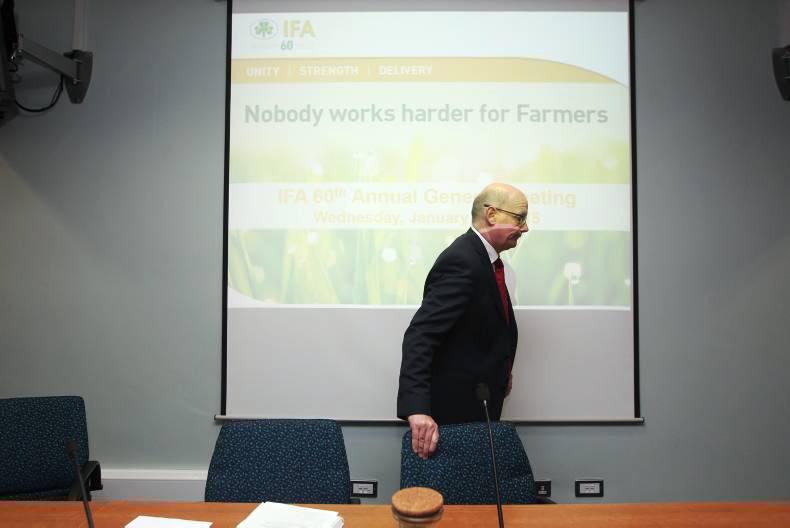Scroll through our timeline of events and read our analysis below.

When John Dillon won the fiercely contested IFA Presidential election in 2001, it was seen as a victory for the small farmer, for the grassroots. Dillon pledged to connect Bluebell back to the heartland of the organisation’s roots.
Fourteen years later, the IFA is in the dock, accused of losing its soul. It has lost its general secretary, Pat Smith, and Dillon’s latest successor, Eddie Downey, has resigned while Con Lucey comes in to assess the structural damage. There is a sense that IFA will only get one chance to restore public opinion – if it fails, the organisation will diminish.
What happened in between? How did the organisation’s leaders get so detached from the rank and file farmers? Who knew what, and when?
It would be easier in a sense if the blame could be assigned to some single dark force that changed the IFA’s nature. However, this is not a Hollywood blockbuster, it’s real life, and the truth is much more mundane.
This was a systems failure, with the general secretary setting the president’s remuneration, and the president, along with the treasurer, setting the general secretary’s. Written as bluntly as that, it looks horrific, smacking of a cosy arrangement. The process was wrong, and was wrong for a long time. Yet John Dillon lived with it, as did his treasurer, Padraig Walshe. Then Padraig became president, with Ruadhri Deasy as treasurer. The process continued after Michael Berkery stepped down.
Pat Smith was appointed from a shortlist of three internal candidates, by an interview panel including Walshe, Deasy, deputy president Derek Deane, Teagasc’s Prof Gerry Boyle, and a recruitment expert from Deloitte. We know he was given a permanent contract, starting at €250,000/annum. He carried forward, it would appear, an entitlement to a percentage of the profits of IFA Telecom, a company he set up in his previous role of director of organisation.
Pat Smith is a good negotiator, but it beggars belief that he secured better terms than the man that he was replacing. What was the benchmark? The common belief was that Pat Smith’s pay was benchmarked somewhere in line with the secretary general of the Department of Agriculture. Now we know it was twice that when bonuses are added in.
The detailed answer to the question of who knew what, and when, may emerge over time. Most of the former presidents and treasurers featured in the timeline above have told the Irish Farmers Journal they would have no problem with full disclosure of what happened on their watch, provided it was as part of a fuller picture.
Successive presidents and treasurers, excellent at debating CAP reform or campaigning on factory prices, may out of their depth in evaluating or reviewing corporate pay. Given the close working relationship between president and general secretary, members may feel that objectivity might be hard to maintain. Successive treasurers signed off on the chief executive’s remuneration up to 2013 at pay levels that are now proving embarrassing, even shocking.
Two weeks of revelations concerning systems failures that date back to the start of the millennium, a cycle of inadequate structures, good intentions and, almost certainly, deep regret.
Read more
Full coverage: Turmoil at the IFA
Scroll through our timeline of events and read our analysis below.

When John Dillon won the fiercely contested IFA Presidential election in 2001, it was seen as a victory for the small farmer, for the grassroots. Dillon pledged to connect Bluebell back to the heartland of the organisation’s roots.
Fourteen years later, the IFA is in the dock, accused of losing its soul. It has lost its general secretary, Pat Smith, and Dillon’s latest successor, Eddie Downey, has resigned while Con Lucey comes in to assess the structural damage. There is a sense that IFA will only get one chance to restore public opinion – if it fails, the organisation will diminish.
What happened in between? How did the organisation’s leaders get so detached from the rank and file farmers? Who knew what, and when?
It would be easier in a sense if the blame could be assigned to some single dark force that changed the IFA’s nature. However, this is not a Hollywood blockbuster, it’s real life, and the truth is much more mundane.
This was a systems failure, with the general secretary setting the president’s remuneration, and the president, along with the treasurer, setting the general secretary’s. Written as bluntly as that, it looks horrific, smacking of a cosy arrangement. The process was wrong, and was wrong for a long time. Yet John Dillon lived with it, as did his treasurer, Padraig Walshe. Then Padraig became president, with Ruadhri Deasy as treasurer. The process continued after Michael Berkery stepped down.
Pat Smith was appointed from a shortlist of three internal candidates, by an interview panel including Walshe, Deasy, deputy president Derek Deane, Teagasc’s Prof Gerry Boyle, and a recruitment expert from Deloitte. We know he was given a permanent contract, starting at €250,000/annum. He carried forward, it would appear, an entitlement to a percentage of the profits of IFA Telecom, a company he set up in his previous role of director of organisation.
Pat Smith is a good negotiator, but it beggars belief that he secured better terms than the man that he was replacing. What was the benchmark? The common belief was that Pat Smith’s pay was benchmarked somewhere in line with the secretary general of the Department of Agriculture. Now we know it was twice that when bonuses are added in.
The detailed answer to the question of who knew what, and when, may emerge over time. Most of the former presidents and treasurers featured in the timeline above have told the Irish Farmers Journal they would have no problem with full disclosure of what happened on their watch, provided it was as part of a fuller picture.
Successive presidents and treasurers, excellent at debating CAP reform or campaigning on factory prices, may out of their depth in evaluating or reviewing corporate pay. Given the close working relationship between president and general secretary, members may feel that objectivity might be hard to maintain. Successive treasurers signed off on the chief executive’s remuneration up to 2013 at pay levels that are now proving embarrassing, even shocking.
Two weeks of revelations concerning systems failures that date back to the start of the millennium, a cycle of inadequate structures, good intentions and, almost certainly, deep regret.
Read more
Full coverage: Turmoil at the IFA











SHARING OPTIONS